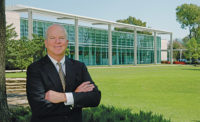
Mike Colyn
Practice Builder
Kimley-Horn
Construction starts in the Seattle-Tacoma-Bellevue area are galloping back from a nadir of $11.8 billion in 2023 and aren’t expected to slow anytime soon.
According to Dodge Data & Analytics, project starts will reach $17.4 billion in 2025, supported by a major boost in non-building numbers.
“The infrastructure construction market remains strong,” Colyn says. “I don’t see that changing in the short term.”
The city of Seattle has shown a commitment to enhancing infrastructure with a proposed $1.45-billion levy aimed at bolstering transportation safety and maintenance, Colyn says, and this would include sidewalk improvements, transit enhancements and bridge maintenance. Meanwhile, WSDOT is moving forward with several major projects aimed at easing congestion and modernizing transportation corridors. These and other transportation upgrades are further bolstered by federal funding from the 2021 infrastructure bill, he says.
These efforts show up in the Dodge numbers: Highways and bridges lead the non-building sector with a forecast of $2.3 billion in starts for 2025, up nearly 200% from four years prior.
One of the most visible efforts is the $806-million Waterfront Seattle project, an ambitious, multiyear effort to completely rebuild the city’s historic waterfront. The project, led by Seattle’s Office of the Waterfront and Civic Projects, is slated for completion next year.
The project consists of a park promenade along the water, a new surface street along the rebuilt Alaskan Way, rebuilding Pier 58 and Pier 62, building an elevated connection from Pike Place Market to the waterfront and improving east-west connections between downtown and Elliott Bay.
Kimley-Horn is a subconsultant for the program, and Colyn has provided expertise across a variety of projects over the last 13 years, including as design manager for the new roadway, bridges and promenade park.
Similarly, Sound Transit also has been an engine for a tremendous amount of engineering and construction work, Colyn says.
“From Kimley-Horn’s work on the conceptual engineering for the Everett Link extension and the upcoming final design proposals for the West Seattle Light Rail, valued at nearly $4 billion, Sound Transit’s agenda reflects a steadfast dedication to expanding transit networks and enhancing regional connectivity,” he notes.
The strong growth in infrastructure investment brings with it headaches of its own.
“While the engineering market appears resilient, there are discernible shifts, particularly in the private sector, where increased interest rates have prompted some slowdowns,” he says.
Many within the Seattle region’s AEC community are increasingly concerned about capacity constraints and talent acquisition. The scarcity of skilled workers has resulted in higher salaries and stiff competition for new graduates and experienced engineers.
Kimley-Horn, Colyn says, extends offers for the following year to its summer interns as early as July and August, allowing the firm to hire the best and brightest.
“Securing top engineering talent has become increasingly challenging amid heightened competition and a limited talent pool,” he says.
“While the engineering market appears resilient, there are discernible shifts, particularly in the private sector, where increased interest rates have prompted some slowdowns.”
—Mike Colyn, Practice Builder, Kimley-Horn
The rising prices for materials also continues to batter bottom lines. According to Colyn, price increases have gone well beyond forecast. An extreme example he offers is PVC: 2023 prices are roughly five to seven times their cost at bid time (2019). Concrete is another concern, with higher-than-average cost increases of about 30% to 40% over a similar period.
“While it is getting better, the industry still hasn’t fully recovered,” he contends.
Residential starts for the region are projected to steadily increase to $6 billion in 2025, a mark still short of 2021’s $6.2 billion. The increase in interest rates is the likely culprit there, Colyn says.
“Office space vacancy rates have continued to increase, and the mayor of Seattle, Bruce Harrell, recently proposed legislation to help developers convert office space for residential use,” he says. And new office space is expected by Dodge’s numbers after taking a step back last year. Office and bank buildings starts are slated to almost double to $1.1 billion for 2025.
“The future of our region is defined by opportunities and challenges,” Colyn says. “With all our public and private sector clients, we are excited to be a part of shaping the future of the Pacific Northwest.”




